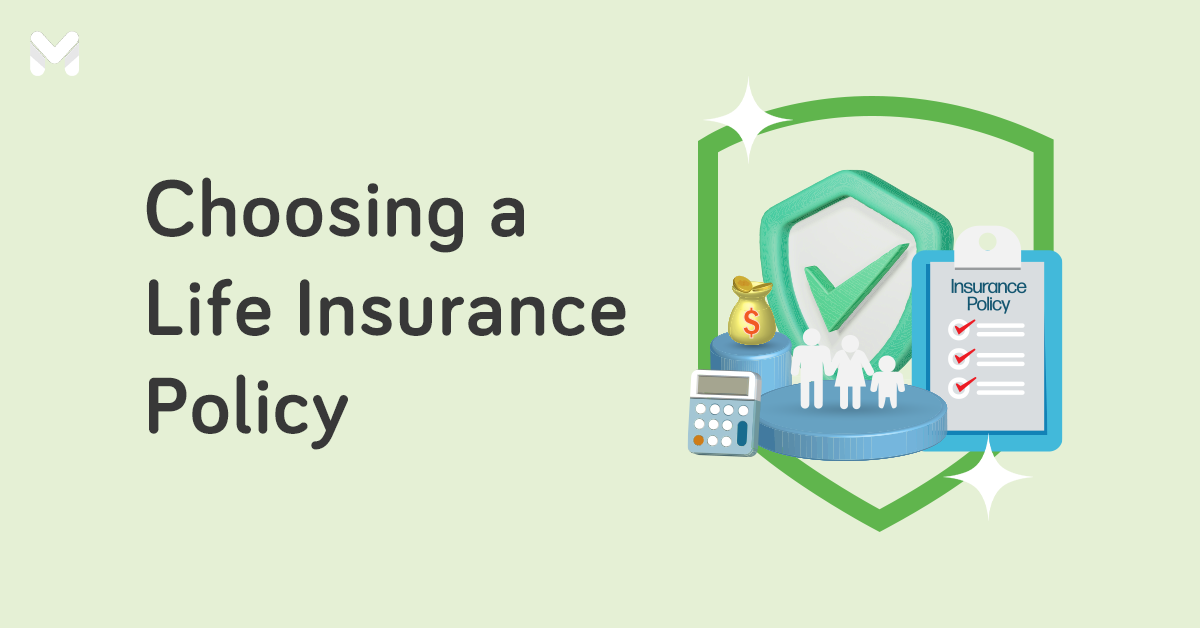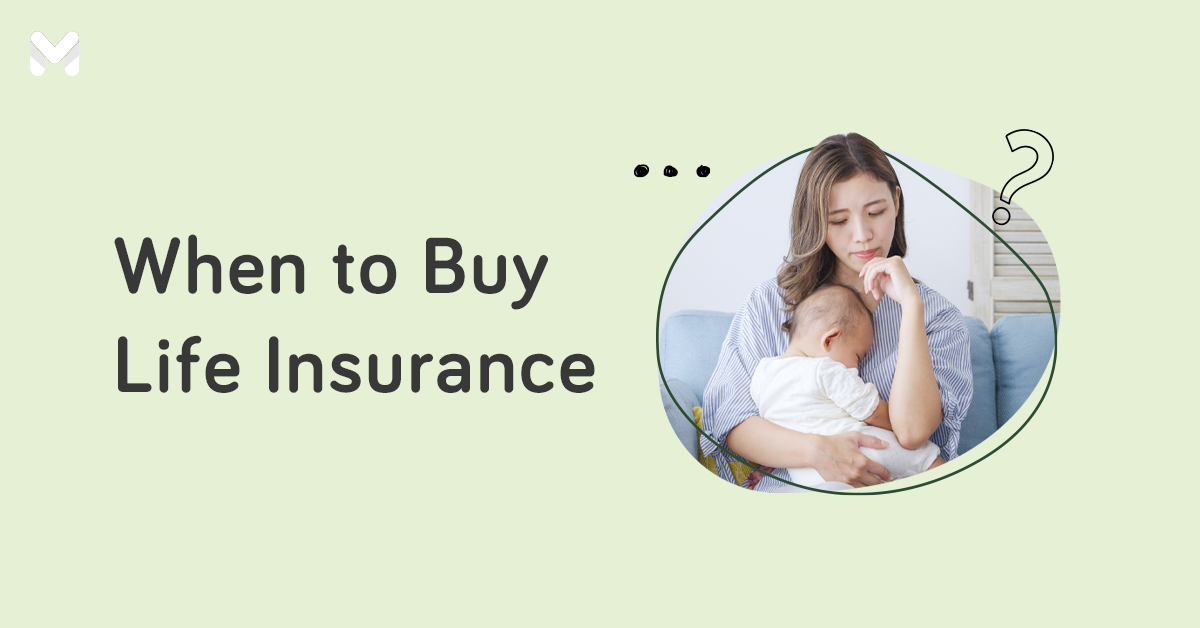Different types of life insurance cater to different needs and goals. That’s why you’ll find many options when looking into life insurance policies.
Having a lot of options can be a good thing. But before you purchase a policy, you need to understand how each option works, how it can fit your needs, and how much it will cost.
To help you decide, here’s a brief overview of life insurance products, how they work, their pros and cons, and who they are best for.
What are the Different Types of Life Insurance Products in the Philippines?
Here are the most common types and their key features:
🛡️ Term Life Insurance
-May-17-2024-07-31-25-1042-AM.png?width=600&height=400&name=Pics%20for%20blog%20-%20600x400%20(8)-May-17-2024-07-31-25-1042-AM.png)
Among the types of life insurance in the Philippines, term insurance is the most affordable and straightforward—there are no hidden fees!
The payment and coverage are for a limited term or number of years, typically between one and thirty years. As the insured, you choose your preferred term or how long the policy will remain active.
When the term is over, you can renew your policy until you reach the plan’s maximum issue age. However, note that you will pay higher rates every time you renew it.
In case of death during the period that the term insurance is active, your beneficiaries will receive a cash benefit.
You also have the option to add different types of life insurance riders or supplementary benefits to enhance your insurance coverage.
Best for:
- Young people who are starting to take care of their finances and become financially independent
- Parents and breadwinners who want a simple and low-cost life insurance policy
- People who want life insurance to cover income replacement or to pay off mortgage or other significant debts when they pass away
Pros of Term Insurance:
It’s the most straightforward and affordable life insurance policy, with benefits sufficient for most people’s needs. You can also get optional riders, including accident protection, critical illness, daily hospital allowance, living benefits, waived premiums, and more.
Moreover, some term life insurance policies can also be converted into whole life insurance, which covers you for life. Note that there’s typically a term conversion rider, and it’s subject to a cut-off period.
Cons of Term Insurance:
Once the term insurance policy expires, all premiums are considered spent. So if you outlive the term coverage, your coverage ends. You won't receive any benefits. If there are any supplementary benefits, you can avail of them only while the policy is active.
While you have the option to renew, your insurance premium will increase because your morbidity and mortality risks also increase.
There's no savings and investment component because it’s a no-nonsense, low-cost life insurance policy.
Read more: Beginner's Introduction to Life Insurance: What it is and How it Works
🛡️ Whole Life Insurance
-May-17-2024-07-33-37-6652-AM.png?width=600&height=400&name=Pics%20for%20blog%20-%20600x400%20(9)-May-17-2024-07-33-37-6652-AM.png)
Just as its name suggests, whole life insurance covers you for life or until you reach the age of 100. As the simplest type of permanent life insurance, a whole life policy does not expire as long as you pay your premiums. These premiums remain fixed but usually cost more than term life insurance.
Aside from the death benefit paid to the beneficiaries, this type of life insurance policy comes with a savings component called cash value. This cash value[1] increases over time as you pay your premiums.
You can withdraw or take out a loan against your insurance policy if you need emergency funds. The amount will be deducted from the face value or the amount your beneficiaries will receive.
Best for:
- People who want a simple permanent life insurance policy
- People who want lifelong insurance coverage, fixed premiums, and cash value
- People who can afford the cost of higher premiums
Pros of Whole Life Insurance:
Many factors make whole life insurance an attractive option. For one, the policy will last your whole life. Plus, the death benefit is guaranteed as long as you pay the premiums.
Moreover, you can borrow against or withdraw funds from your policy. This makes it an excellent lifelong asset that can help you meet different financial goals in various life stages.
You also enjoy fixed premiums throughout the duration of the policy. Your premiums won’t be subject to market conditions.
Cons of Whole Life Insurance:
As mentioned, premiums are higher for whole life insurance policies. Because the premium payments and death benefits are fixed, you also can’t adjust your plans.
Moreover, whole life insurance policies usually require a medical exam. You can waive this step, but at the cost of a higher premium.
Plus, it takes time for the cash value to build, typically around 10 years.
Related: Do You Really Need Life Insurance? Yes—Here's Why
🛡️ Universal Life Insurance
-May-17-2024-07-35-09-2941-AM.png?width=600&height=400&name=Pics%20for%20blog%20-%20600x400%20(10)-May-17-2024-07-35-09-2941-AM.png)
This permanent life insurance covers you your whole life as long as you pay premiums and meet all the policy requirements.
Like whole life insurance, universal life combines lifelong protection with a savings component. The minimum premium covers the administrative fees and the death benefit. Anything you pay more than that gets added to the cash value.
When you pay your premiums, this accrues cash value according to a minimum annual interest rate, which the insurance company sets. You can access this cash value when you need it.
The death benefit will also be paid out to your beneficiaries in the event of your death.
Compared to whole life, universal life insurance offers more flexibility. You can move your money between the cash value and the death benefit―reducing the death benefit or increasing the cash value and vice versa―as long as it’s within the insurer’s limits.
Best for:
- People who want cost-efficient, life-long protection
- People who prefer the flexibility to raise or lower their insurance premiums
- People who prefer a more hands-on approach to managing their life insurance policy
Pros of Universal Life Insurance:
With this policy, you build cash value and use it while you’re alive to help fund different financial needs.
Moreover, you can adjust the frequency or size of your premiums, which can be handy when your budget is tight. Lastly, as long as you have sufficient balance in your policy, it will pay out a death benefit to your beneficiaries.
Cons of Universal Life Insurance:
You must closely monitor your universal life insurance policy, particularly its cash value, if you don’t want your policy to be underfunded. If that happens, you may have to make more significant payments to keep the coverage. Plus, if you underpay for a long time, this may decrease the death benefit or cause the policy to lapse.
🛡️ Variable Life Insurance
-May-17-2024-07-38-00-3207-AM.png?width=600&height=400&name=Pics%20for%20blog%20-%20600x400%20(11)-May-17-2024-07-38-00-3207-AM.png)
Like whole and universal life insurance, variable universal life (VUL) provides a cash value savings component and death benefit. It’s a permanent policy that offers flexible premiums and death benefits.
The difference with this type of universal life insurance, however, is that it invests the cash value in assets such as mutual funds, which can be purchased only within the policy. This means the cash value growth is tied to the investments' performance.
VULs charge a higher premium than what it costs to insure you. This is because the extra money from the premium payments is invested so that the policy builds a cash value.
Best for:
- People with a higher risk tolerance when it comes to investments
- People who want greater control over their cash value investments
Pros of Variable Universal Life Insurance:
Fund experts professionally manage the funds chosen for VULs. If the investments perform well, your VUL policy can become worth more than other products such as whole or universal life. Thus, it can offer liquidity and higher investment returns in addition to life protection.
Cons of Variable Universal Life Insurance:
Your life insurance policy's value can decrease if investments perform poorly. Thus, your premiums may increase to ensure there’s enough money to invest. Moreover, this type of life insurance plan offers no guarantees against investment risks.
🛡️ Final Expense Insurance
-May-17-2024-07-39-41-9117-AM.png?width=600&height=400&name=Pics%20for%20blog%20-%20600x400%20(12)-May-17-2024-07-39-41-9117-AM.png)
Also known as funeral or burial insurance, final expense insurance is another example of a whole life insurance policy. It typically has a small death benefit, which can help pay for expenses when the insured dies. However, its main purpose is to pay for funeral costs and final expenses, such as outstanding medical bills.
It’s easy to get approved for final expense insurance since it does not require a medical exam.
Best for:
- People who want to prepare for end-of-life expenses
- People who want to get a life insurance policy but don’t have a lot of options they qualify for
Pros of Funeral Expense Insurance:
Although premiums are higher, they remain fixed throughout the policy period. Because it usually does not require a medical exam, it’s a more accessible option for people with pre-existing health conditions.
Cons of Funeral Expense Insurance:
They vary depending on the coverage amount, but generally, premiums are high. This is because there’s not enough health information on which to base the insurance premiums.
The benefit amount is also smaller than that of other types of life insurance. Your beneficiaries may be left with little after paying funeral and burial costs.
At a Glance: Comparison of the Different Types of Life Insurance
Here's a quick comparison of the policies mentioned above:
| Type of Life Insurance | Policy Length | Premiums | Cash Value | Death Benefit |
| Term Life | Temporary (usually 30 years) | Cheapest; no hidden fees | ❌ | Guaranteed |
| Whole Life | Whole life | Fixed; more expensive | ✔️ | Flexible |
| Universal Life | Whole life | Flexible; more expensive | ✔️ | Flexible |
| Variable Universal Life | Whole life | Flexible; more expensive | ✔️ | Flexible |
| Funeral Expense | Whole life | Fixed; more expensive | ✔️ | Guaranteed |
Read more: Should You Get Life Insurance? Consider These 8 Factors
How to Choose the Right Type of Life Insurance Policy
-May-17-2024-07-41-21-8889-AM.png?width=600&height=400&name=Pics%20for%20blog%20-%20600x400%20(13)-May-17-2024-07-41-21-8889-AM.png)
The right type of life insurance policy is one that’s suited for your long-term financial goals and needs. Also, consider your current financial situation to choose one that’s right for your budget.
If you’re in your 20s or 30s, married, and with a family, purchase term life insurance with extensive coverage at an affordable price.
For example, FWD Insurance’s The One for Life has a benefit term of one year, with death benefits renewable up to age 99 and critical illness and accidental death benefits renewable up to age 79. Your premium won’t increase after every five years if you renew it right after the end of your current plan.
If you want lifetime protection and cash value growth, permanent policies are your best option. Choose from whole life, universal, or variable universal life insurance depending on how comfortable you are with risk and how much freedom you want in changing your premiums and death benefits over time.
FWD's Set for Life is an investment-linked insurance plan that provides insurance coverage, death benefits, and accidental death benefits. It also offers packages with add-on benefits for enhanced coverage, such as critical illness, multiple critical illness, and hospital cash benefits. Choose from a benefit term of whole life or five, seven, and 10 years.
Meanwhile, FWD's Set for Health offers protection for up to 75 years old and provides major and minor critical illness benefits, death benefits, and healthy life benefits. If you are diagnosed with any of the 42 major critical illnesses, you will receive 100% of the benefit amount (and up to 300% of the coverage if you meet certain conditions). The minor critical illness benefit will give you 20% of the benefit amount if you are diagnosed with any of the covered 15 minor critical illnesses.
If you never file a claim for major critical illnesses and your policy is still active until its expiry date, you will get 100% of your total premiums paid.
Read more: Moneymax and FWD Life Insurance Empower Filipinos to Make Better Financial Decisions
Final Thoughts
That’s a wrap on the most common types of life insurance explained! Hopefully, you now have a better idea of which types of life insurance policies best suit your needs.
Because life insurance policies are a significant financial commitment, get yours from an insurance company with a proven track record of financial success. With FWD, you can easily understand the different policies, purchase one, and file a claim. Get started by clicking the banner below:
DISCLAIMER: This article was created in partnership with FWD Philippines. While we are financially compensated for this collaboration, we ensure to maintain our editorial integrity to provide you with the best recommendations that can help you make smarter financial decisions.
Source: [1] What Is Cash Value in Life Insurance? Explanation With Example (Investopedia, 2024)







_1200x350.png?width=1200&height=350&name=FWD_Life_Insurance_Generic_(Mar_2024)_1200x350.png)


